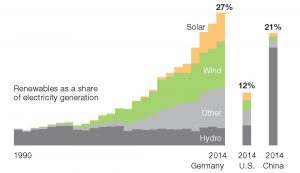Germany’s energiewende is an energy revolution that made them a leader in industrialized nations. As of today, 27% of Germany’s energy comes from renewable resources (more than twice that of the United States). They have pledge to reduce their carbon emissions by 40% by 2020, and 80% by 2050. This post explores the political, economical, and social situation that allowed such sweeping changes in the national energy system.

Political
After the second world war, Germany was a divided nation. The German Green party came to power in 1980 amid nuclear power protests in West Germany and began bringing green ideology to the public’s attention. After Chernobyl exploded in 1986 one of Germany’s two major parties, the Social Democrats, joined the anti-nuclear cause. In 1998, these two parties formed a governing coalition. Two years later, a law was passed that guaranteed any renewable energy producer a price that more than covered costs, and the feed-in tariffs were guaranteed for 20 years. This provided the incentive needed for investors to start putting significant money into renewable energy.
Economical
Since the passing of the 2000 law, the tariff for a large new solar plant has fallen from 50 cents per kilowatt hour to just 10 cents per kilowatt hour. Over half of the investments in green energy have come from private citizens or local citizens associations. Further, no more of Germany’s gross domestic product is devoted to energy today than was in 1991. Instead, the money came from a surcharge on citizens electricity bills. The cost to the average user is about 18 euros a month, a not insignificant charge considering Germany already has the second-highest cost for electricity in all of Europe. However, despite these extra fees, the approval rating for energiewende from German citizens is an incredible 92%.
Social
Perhaps the most driving force for change in Germany’s energy production was the social climate. It began in the 1970’s, when serious harm to the nation’s forests from acid rain due to fossil fuel emissions caused widespread outrage. Germans place a high value on their undeveloped land, with their forests topping the list. Initially, the government proposed nuclear energy as a cleaner alternative energy source and it once produced a quarter of the country’s energy. However, when the disasters at Chernobyl and Fukushima struck, the citizens pushed back hard. In 1975, a nuclear power plant was proposed to the town of Freiburg, sparking almost of decade of protests and occupying of the site. Today, Freiburg is a completely solar powered city, producing more energy than it uses. Germany has currently shut down 9 of it’s 27 nuclear reactors, with plans to close the rest by 2020.
Reference:
Kunzig, R. (2015, October 15). Germany Could Be a Model for How We’ll Get Power in the Future. National Geographic.
